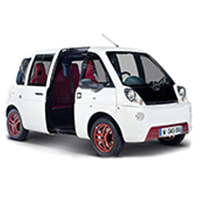
Catalog / Mia
Mia Electric: Redefining Urban Mobility with Innovative Design
Mia Electric, a French automotive company, emerged as a visionary player in the electric vehicle (EV) market, focusing on innovative, compact, and eco-friendly urban mobility solutions. Founded in 2010 by Edwin Kohl, a German entrepreneur, Mia Electric set out to challenge conventional automotive design and address the growing need for sustainable transportation in crowded urban environments.
The company's history is intrinsically linked to its flagship model, the Mia electric car. Designed by Murat Günak, former head of design at Volkswagen, the Mia was conceived as a 'microbus' - a revolutionary concept that maximized interior space while maintaining a minimal footprint. This unique approach to automotive design was a direct response to the challenges of urban congestion and the increasing demand for environmentally friendly vehicles.
One of the most distinctive features of the Mia was its central driving position, reminiscent of the iconic McLaren F1 supercar, but applied to a small, practical city car. This unconventional layout allowed for excellent visibility and maneuverability in tight urban spaces. The Mia was also notable for its sliding doors on both sides, which made entry and exit easy even in narrow parking spots.
Mia Electric introduced three main variants of its electric vehicle:
- Mia U: The basic urban version with three seats
- Mia L: An extended version with four seats
- Mia Box Van: A compact commercial version for urban deliveries
The company's commitment to sustainability extended beyond just the electric drivetrain. The Mia was designed with recyclability in mind, using eco-friendly materials in its construction. This holistic approach to environmental responsibility was ahead of its time and set a precedent for future EV manufacturers.
Despite its innovative design and eco-friendly credentials, Mia Electric faced significant challenges. The company struggled with financial difficulties and production issues, which ultimately led to its bankruptcy in 2014. However, the impact of Mia Electric on the automotive industry should not be underestimated. Its bold approach to urban mobility and electric vehicle design inspired other manufacturers and contributed to the ongoing evolution of city-focused EVs.
Although Mia Electric's time in the market was short-lived, its legacy lives on in the continued development of compact, efficient, and innovative electric vehicles designed specifically for urban environments. The company's vision of reimagining urban transportation remains relevant today, as cities worldwide grapple with issues of congestion, pollution, and the need for sustainable mobility solutions.
Mia Electric may have been ahead of its time, but its influence can be seen in the growing market for small, versatile electric vehicles that prioritize space efficiency and environmental responsibility. As the automotive industry continues its shift towards electrification and smart urban mobility, the pioneering spirit of Mia Electric serves as a reminder of the importance of innovative thinking in addressing the transportation challenges of the 21st century.

